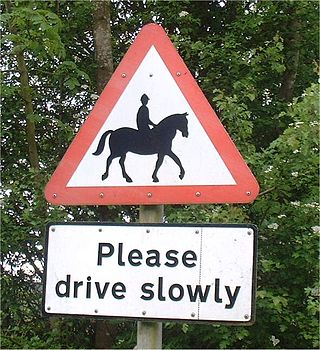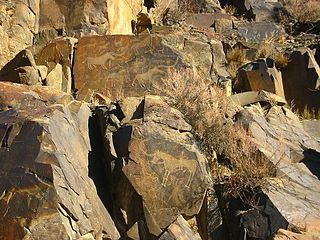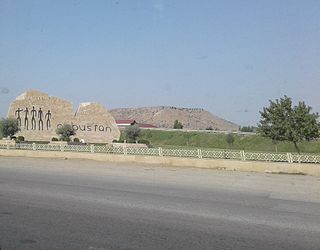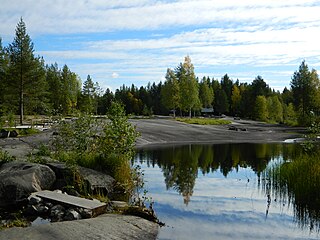The Petroglyphs of Arpa-Uzen can be found in the Karatau mountain range of southern Kazakhstan.
Contents

The Petroglyphs of Arpa-Uzen can be found in the Karatau mountain range of southern Kazakhstan.

The petroglyphs of Arpa-Uzen, located on ancient migration routes, include over 3500 examples of rock art, the most abundant collection in all of southern Kazakhstan. These pictorials depict scenes from life during the Late Bronze Age to Early Iron Age, portraying the domestication and sacrifice of animals amongst other things. A palimpsest was formed where in older petroglyphs were covered by Saka pictorials from the Middle Ages. [1]
This site was added to the UNESCO World Heritage Tentative List on September 24, 1998 in the Cultural category. [2] (see List of World Heritage Sites in Kazakhstan)

A pictogram is a graphical symbol that conveys meaning through its visual resemblance to a physical object. Pictograms are used in systems of writing and visual communication. A pictography is a writing system which uses pictograms. Some pictograms, such as hazard pictograms, may be elements of formal languages.

A petroglyph is an image created by removing part of a rock surface by incising, picking, carving, or abrading, as a form of rock art. Outside North America, scholars often use terms such as "carving", "engraving", or other descriptions of the technique to refer to such images. Petroglyphs, estimated to be 20,000 years old are classified as protected monuments and have been added to the tentative list of UNESCO's World Heritage Sites. Petroglyphs are found worldwide, and are often associated with prehistoric peoples. The word comes from the Greek prefix petro-, from πέτρα petra meaning "stone", and γλύφω glýphō meaning "carve", and was originally coined in French as pétroglyphe.

In archaeology, rock arts are human-made markings placed on natural surfaces, typically vertical stone surfaces. A high proportion of surviving historic and prehistoric rock art is found in caves or partly enclosed rock shelters; this type also may be called cave art or parietal art. A global phenomenon, rock art is found in many culturally diverse regions of the world. It has been produced in many contexts throughout human history. In terms of technique, the four main groups are:

The Angono - Binangonan Petroglyphs are petroglyphs carved into a rock wall in Binangonan, Rizal, Philippines. It consists of 127 human and animal figures engraved on the rockwall probably carved during the late Neolithic, or before 2000 BC. They are the oldest known work of art in the Philippines. These inscriptions clearly show stylized human figures, frogs and lizards, along with other designs that may have depicted other interesting figures but erosion may have caused it to become indistinguishable. The engravings are mostly symbolic representations and are associated with healing and sympathetic magic.

Writing-on-Stone Provincial Park is located about 100 kilometres (60 mi) southeast of Lethbridge, Alberta, Canada, or 44 kilometres (30 mi) east of the community of Milk River, and straddles the Milk River itself. It is one of the largest areas of protected prairie in the Alberta park system, and serves as both a nature preserve and protection for many First Nations (indigenous) rock carvings and paintings. The park is sacred to the Blackfoot and many other aboriginal tribes.

Sarmishsay is located in the Karatau Mountain Range in the Nurata District of Navoiy Region of Uzbekistan. The gorge contains archeological remains dating back as far as the Stone Age, including two petroglyph sites with a total of 10,000 ancient rock carvings. According to UNESCO, it is the largest and most important rock art monument in Uzbekistan.

Tamgaly is a petroglyph site in the Zhetysu of Kazakhstan. Tamgaly became a UNESCO World Heritage Site in 2004. Tamgaly is located 170 km northwest of Almaty.

Twyfelfontein, officially known as ǀUi-ǁAis, is a site of ancient rock engravings in the Kunene Region of north-western Namibia. It consists of a spring in a valley flanked by the slopes of a sandstone table mountain that receives very little rainfall and has a wide range of diurnal temperatures.

Qobustan is a settlement and municipality in Baku, Azerbaijan. It has a population of 14,470.

The Zarautsoy Rock Paintings are a gallery of rock art contains the oldest petroglyphs in Central Asia. The images describe primitive man's everyday life, and bull and wild goat hunting. The site is located in the Surxondaryo Region of Uzbekistan.
The Petroglyphs of Eshkiolmes are located throughout the Eshkiolmes mountain range in the Almaty region of Kazakhstan. The area is being considered for inscription on the World Heritage list of sites who have "outstanding universal value" to the world.

The Rock Paintings of Tsagaan Salaa are located in western Mongolia. Site is inside Altai Tavan Bogd National Park and was approved as part of a larger Petroglyphic Complexes of the Mongolian Altai World Heritage Site along with The Upper Tsagaan Gol Complex in 2011.

The Khoit Tsenkher Cave Rock Paintings are found in Mankhan Sum, Khovd Province, Mongolia.

The Rock Carvings in Tanum are a collection of petroglyphs near Tanumshede, Bohuslän, Sweden, which were declared a World Heritage Site by UNESCO in 1994 because of their high concentration.

Rock Art in the Ha'il Region is the fourth site in Saudi Arabia to be inscribed on the UNESCO List of World Heritage Sites. The rock art includes two components situated in the desert of the Ha'il Region: the first is Om Sinman mountain at the city of Jubbah, and the second is al-Manjor and Raat at Al-Shuwaymis. An ancient population left traces of their passings in petroglyphs on the rock's surface, holding 8,000 years of history.

Gobustan Rock Art represents flora and fauna, hunting, lifestyles, and culture of pre-historic and medieval periods of time. The carvings on the rocks illustrates men, ritual dances, men with lances in their hands, animals, bull fights, camel caravans, and pictures of the sun and stars. The date of these carvings goes back to 5,000 – 20,000 years before present.

Petroglyphs of Lake Onega and the White Sea is a UNESCO World Heritage Site in Russia, Republic of Karelia, listed on 28 July 2021. The World Heritage Site comprises 33 petroglyph sites in two clusters. The rock carvings were created from 7 to 4 millennia ago and represent a glimpse into the lives of Neolithic cultures of Fennoscandia.